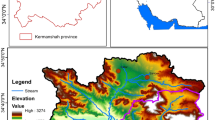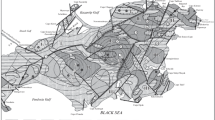Abstract
Fractal dimension index (FDI) and shape index (SI) of the islands of Bangladesh Sundarbans situated at the estuarine part of the Ganges–Brahmaputra–Meghna (GBM) delta were estimated with the aid of remote sensing techniques between the years 1989 and 2010. The main objective was to correlate the temporal change in these two indices within two decades with the possible geomorphic processes regulating these patterns. The Sundarban region is composed of almost 200 islands having self-similar coastlines with FDI and SI ranged from 1.002 to 1.202 and 1.016 to 7.546, respectively. Both FDI and SI values along with their temporal change showed that the complexity and irregularity in the island shape increased in the northern and north-eastern parts of the Sundarbans, while in the southern end it exhibited an opposite trend. Apart from a few exceptions, the longer serrated coastlines of the north (FDI > 1.18) became more serrated and rough due to the predominant tidal effect (particularly ebb tidal flow) within the two decades. The comparatively smoother coastlines of the southern islands (FDI < 1.18) became more compact and circular due to strong sea wave action during the same course of time. The spatial variation in FDI was explained in terms of the relative elevation of the islands, which was found to be lower in the northern part, their differential response to rising sea level and the amplified tidal action in this funnel shaped estuary. Apart from changes in fractal dimension, a net land loss of ≈ 60 km2 was observed within this island system during the study period. These observations imply that with an increasing sea level rise, the northern and southern parts of Sundarbans Island system will respond differentially, resulting in inundation in northern area (water encroachment in the low-lying islands) and land loss in the southern part (erosion in the coastal boundary) causing a severe loss of ecosystem services provided by the mangrove forest.










Similar content being viewed by others
References
Alam M (2003) Bangladesh country case study.In: Asian regional workshop for the preparation of national adaptation programme of action. Thimphu, Bhutan
Annadhason A (2012) Methods of fractal dimension computation. Int J Comput Sci Info Technol Secur 2:166–169
Backes AR, Bruno OM (2008) A new approach to estimate fractal dimension of texture images. In: Abderrahim E, Lezoray O, Noudboud F, Mammass D (eds) Image and signal processing. Springer, Berlin, pp 136–143
Backes AR, Florindo JB, Bruno OM (2012) Shape analysis using fractal dimension: a curvature based approach. Chaos Interdiscip J Nonlinear Sci 22:043103. doi:10.1063/1.4757226
Brammer H, Asaduzzaman M, Sultana P (1996) Effects of climate and sea-level changes on the natural resources of Bangladesh. In: Warrick RA, Ahmad QK (eds) The implications of climate and sea-level change for Bangladesh. Springer, Netherlands, pp 143–203
Dai ZJ, Li CC, Zhang QL (2004) Fractal analysis of shoreline patterns for crenulate-bay beaches, Southern China. Estuar Coast Shelf Sci 61:65–71. doi:10.1016/j.ecss.2004.04.004
Dorandeu J, Le Traon PY (1999) Effects of global mean atmospheric pressure variations on mean sea level changes from TOPEX/Poseidon. J Atmos Ocean Technol 16:1279–1283. doi:10.1175/1520-0426(1999)016<1279:EOGMAP>2.0.CO;2
Gao Y, Su F, Zhou C, Yang X, Sun X, Zhang D (2011) Scale effects of China mainland coastline based on fractal theory. Acta Geogr Sin 66:331–339
Ghosh T, Bhandari G, Hazra S (2003) Application of a ‘bio-engineering’ technique to protect Ghoramara Island (Bay of Bengal) from severe erosion. J Coast Conserv 9:171–178. doi:10.1652/1400-0350(2003)009[0171:AOABTT]2.0.CO;2
Gopal B, Chauhan M (2006) Biodiversity and its conservation in the Sundarban mangrove ecosystem. Aquat Sci 68:338–354. doi:10.1007/s00027-006-0868-8
Iftekhar MS, Islam MR (2004) Managing mangroves in Bangladesh: a strategy analysis. J Coast Conserv 10:139–146. doi:10.1652/1400-0350(2004)010[0139:MMIBAS]2.0.CO;2
Isichenko MB, Kalda J (1991) Statistical topography. I. Fractal dimension of coastlines and number-area rule for islands. J Nonlinear Sci 1:255–277. doi:10.1007/BF01238814
Islam MS (2001) Sea-level changes in Bangladesh: the last ten thousand years. Asiatic Society of Bangladesh, Dhaka
Jorge LAB, Garcia GJ (1997) A study of habitat fragmentation in Southeastern Brazil using remote sensing and geographic information systems (GIS). Forest Ecol Manag 98:35–47. doi:10.1016/S0378-1127(97)00072-8
MacLennan M, Fotheringham AS, Batty M, Longley P (1991) Fractal geometry and spatial phenomena. National center for geographic information and analysis technical report, 91-1
Mandelbrot BB (1967) How long is the coast of Britain? Statistical self-similarity and fractal dimension. Science 156:636–638
Mandelbrot BB (1975) Stochastic models for the Earth’s relief, the shape and the fractal dimension of the coastlines, and the number-area rule for islands. Proc Natl Acad Sci USA 72:3825–3838
Mandelbrot BB (1983) The fractal geometry of nature. Macmillan, New York
Morais PA, Oliveira EA, Araújo NA, Herrmann HJ, Andrade JS Jr (2011) Fractality of eroded coastlines of correlated landscapes. Phys Rev E 84:016102. doi:10.1103/PhysRevE.84.016102
Mukherjee S, Mukhopadhyay A, Sananda ABAM (2012) Digital elevation model generation and retrieval of terrain attributes using CARTOSAT-1 stereo data. Int J Sci Tech 2:265–271
Nayak C (2008) Comparing various fractal models for analysing vegetation cover types at different resolutions with the change in altitude and season. Masters Thesis, ITC Netherland and IIRS India
Okubo PG, Aki K (1987) Fractal geometry in the San Andreas fault system. J Geophys Res: Solid Earth 92:345–355. doi:10.1029/JB092iB01p00345
Pethick JS (1984) An introduction to coastal geomorphology. Department of Geography, University of Hull, Hull
Pethick J, Orford JD (2013) Rapid rise in effective sea-level in southwest Bangladesh: its causes and contemporary rates. Glob Planet Change 111:237–245. doi:10.1016/j.gloplacha.2013.09.019
Sarwar MGM (2005) Impacts of sea level rise on the coastal zone of Bangladesh. Masters Thesis, Lund University, Sweden
Schwimmer RA (2008) A temporal geometric analysis of eroding marsh shorelines: can fractal dimensions be related to process? J Coast Res 24:152–158. doi:10.2112/06-0644.1
Wentz EA (1997) Shape analysis in GIS. In: Proceedings of Auto-Carto, vol 13, pp 204–213
Wentz EA (2000) A shape definition for geographic applications based on edge, elongation, and perforation. Geogr Anal 32:95–112. doi:10.1111/j.1538-4632.2000.tb00419.x
Acknowledgments
This work was done under the project ‘Assessing Health, Livelihoods, Ecosystem Services and Poverty Alleviation in Populous Deltas [NERC Grant References: NE/J002755/1]’ which was executed with funding support from the Ecosystem Services for Poverty Alleviation (ESPA) programme. The ESPA programme was funded by the Department for International Development (DFID), the Economic and Social Research Council (ESRC) and the Natural Environment Research Council (NERC). Authors are very grateful to ESPA, DFID, ESRC and NERC. Dr. R. J. Nicholls and Mr. Duncan Hornby of University of Southampton and Dr. Andres Payo of Oxford University have carefully reviewed the manuscript and suggested some modifications. Their help is gratefully acknowledged. The authors are also indebted to Survey of Bangladesh (SOB), Institute of Water Modelling (IWM), Govt. of Bangladesh and Centre for Environmental and Geographic Information Services (CEGIS), Bangladesh to carry out the present work.
Author information
Authors and Affiliations
Corresponding author
Rights and permissions
About this article
Cite this article
Hazra, S., Mukhopadhyay, A., Chanda, A. et al. Characterizing the 2D shape complexity dynamics of the islands of Sundarbans, Bangladesh: a fractal dimension approach. Environ Earth Sci 75, 1367 (2016). https://doi.org/10.1007/s12665-016-6175-3
Received:
Accepted:
Published:
DOI: https://doi.org/10.1007/s12665-016-6175-3




